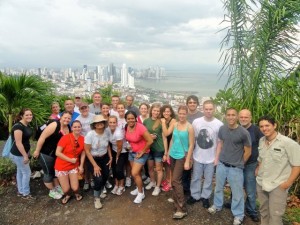I left the US on May 23 and arrived in Madrid, Spain on May 24. The plane ride was okay but really long and really uncomfortable I couldn’t really sleep well at all. Madrid was cool, we were there for a couple of days. There was a lot of people and I started feeling culture shock while there because of the time difference and internet issues I had there. I couldn’t really get in touch with my family like I wanted to so I was kind of bummed out. We toured around the city and saw some awesome architecture! El palacio real is absolutely beautiful! That is the royal palace in Madrid. It was interesting to see American restaurants there too like McDonalds and Burger King. They were right by our hotel. We looked at the menu and it was interesting to see the menu items which were different from home.
Once we left Madrid we went to Toledo and I absolutely fell in love with the city!! It is beautiful and Toledo is the image that comes to your mind when you think of Old World Europe! The people were so friendly there which was unlike Madrid. Madrid reminds me of a large busy city like New York and Toledo is much smaller, friendlier, as well as prettier! I loved it! Unfortunately we were only there for one day, I wish we had been able to spend more time there. I plan to go back one day, maybe not during my study abroad but definitely one day I will visit Toledo again.
After Toledo we were on our way to Sevilla which is where I am studying. We arrived and my room mate Cortney and I met our house mother Marie. She is so sweet and I absolutely love her! She has lived in Sevilla her entire life and has a beautiful home! She has three grown children and three grandchildren (one on the way due in July). My room mate and I were surprised when we arrived to her house to see how big it was. We were already prepared to have a small amount of space during our stay and we assumed we would be sharing a room. We actually have our own rooms and we have a lot of space! She lives in an apartment but to me this is more like a condo. She has so much space! She’s really awesome and she has embraced Cortney and myself as her Spanish daughters. She doesn’t speak much Spanish and sometimes we misunderstand each other but we are learning. She has had many students here with her before so she is very patient with us. We are experiencing all of the differences in culture compared to back at home. There is a difference in the eating schedule because the largest meal is lunch which is around 2 PM and then we don’t eat again until around 9 or 10 PM and dinner is usually a light meal as is breakfast. I am still getting adjusted to that because sometimes I get hungry in between that time. They don’t really snack here and that is also something I’m not used to. Also the home is not used as a hang out spot like back at home. My room mate asked our house mom if she was okay with some of our friends coming over and she didn’t want that to happen. You hang out with your friends outside of the home. There’s many other things that we are learning but like I said our house mom is very patient with us.
The weather is Spain is beautiful except it gets REALLY hot some days. The other day we were walking around and it literally felt like we were walking in an oven! It was miserable! The plants and flowers over here are very beautiful however. Classes are going well, I am taking International Finance and Marketing to finish my International Business minor. My professors are pretty laid back and I know this time will fly by in no time!
I discover new things everyday and that makes it so exciting! I am so thankful and blessed to have this opportunity and I am cherishing my time here because I know that it will be over before I know it! We are traveling to Morocco this coming Thursday so once we get back I’ll have to post about my experience there. Until then hasta luego!

